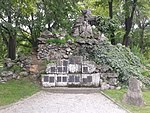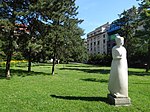Pioneers Park, Belgrade
| Pioneers Park | |
|---|---|
| Пионирски парк | |
 Pioneers Park | |
| Location | Stari Grad, Belgrade |
| Coordinates | 44°48′38″N 20°27′52″E / 44.8105°N 20.4644°E |
| Created | 1944 |
| Open | All year |
Pioneers Park (Serbian: Пионирски парк) is a park in Belgrade, the capital of Serbia. Developed from the royal garden, which itself was a successor of a much older garden, it is today one of the central city parks. It has been open for public since 1944.[1] The park has been declared a botanical natural monument.[2]
Location
The park is located in the municipality of
Though they are intersected with the streets, Pioneers Park forms a larger green sector with the surrounding parks and green areas: Tašmajdan Park (east), Park at the National Assembly (north), Andrićev Venac (west) and Park Aleksandrov (further west, across the Kralja Milana). Easternmost point of the park, at the crossroad of the Bulevar Kralja Aleksandra, Kneza Miloša and Takovska streets, it the tripoint of the municipalities Vračar, Stari Grad and Palilula.[3][4]
History
Origin
The garden already existed at least in the early 18th century. During the
Royal Garden
King Milan (ruled 1868-89) invested much time and funding into the garden, more than any other ruler. Even today some of the plants from that period survive. British traveler
King Milan decorated the garden by planting the exotic trees. The function of the court gardener had great influence in the garden decoration. In 1890s, that function was done by Johan Sneider, a horticultural expert from Austria. A part of the garden spreading from the Stari Dvor down Dragoslava Jovanovića, Bulevar Kralja Aleksandra and Kneza Miloša, up to the former Ministry of Army, was enclosed with an over 3 m (9.8 ft) high fence. The entrances were towards Kralja Aleksandra Boulevard and Dragoslava Jovanovića. One guard post was placed at the very corner of Kralja Aleksandra and Kneza Miloša, and the rest of them were placed next to each gate. The fence was made of metal rods, which, until the construction of the Stari Dvor and setting up the new metal fence with more richly decorated gates, were gilded. The gates obtained the triumphal appearance with the prominent plastic decoration and heraldic emblems probably after the construction of the Novi Dvor and the decoration of the court garden with the fountain between the courts. During the garden decoration, the English landscape – free style was applied in Serbia for the first time, conditioned with the existing vegetation in that area. Later on, the French-geometrical style was used particularly in the space between two courts. The court garden was divided into the "garden" faced towards Kralja Milana, which was a representative part of the court whole, and the "park" in the back area, enclosed with the brick fence. In the central part of the park there was a pool with the sculpture of a naked girl holding a jug in her hand, the sculpture which was imported from Vienna, and which still stands there. Behind the Old Konak in the garden, apart from the trees from Serbia (oak, linden, maple) some exotic types of trees were planted (black walnut, honey locust, koelreuteria, paulownia, catalpa).. It is assumed that most of the saved trees originates from Josif Pančić's botanical garden.
At the beginning of the 19th century, conifers of column-like shape were planted, probably thujas and blue spruces, around the entrance to the konak, as well as the thick planted conifers towards the court, and after the demolition of the Old Konak in 1904, the area of the garden increased a lot. The planted trees in the garden advanced over the time, so this part of the park is nowadays rich in the most significant and the oldest vegetation. Until the World War II the area of the court complex on Terazije was enclosed.
The construction of the new royal palace,
Soviet intelligence agent
After World War II

The new Communist authorities removed the fence in 1944, making the garden public and naming it the Pioneers Park.[1] After the reconstruction done when the Second World War ended, the former court complex was conceived as the administrative federal and republic center, so the court guard building and many utility buildings were demolished. One of the most important projects of this reconstruction was orienting the former court complex towards the National Assembly building, thus realizing the idea about the forming of the representative administrative centre. The redecoration of the court garden started after the design of the architect Aleksandar Đorđević, and finished after the design of the forestry engineer Vladeta Đorđević.[1]
An area between the park and the Kralja Milana street, east of the Novi Dvor, was arranged as an modernist, artistic promenade with an artificial stream and named after the writer Ivo Andrić, Nobel laureate, Andrićev Venac. The monument to Ivo Andrić was erected on the promenade.
Today, the park covers an area of 3.6 ha (8.9 acres),[2] of which 2 ha (4.9 acres) is forested.[1] The area of the park, which by origin belongs to the type of the residential parks, consists of three parts, different in concept: the part towards Bulevar Kralja Aleksandra decorated in free style, the area between the courts with the fountain, and the green, flower area in front of the Stari Dvor. Under the flower area and the driveway to the city hall an underground garage was built. It has 455 parking spots on three levels and was open on 1 April 2005. It was fully renovated and expanded to 461 parking spots in February 2019.[11]
In 2009 the park was declared a botanical natural monument.[1]
The park was in a fairly bad shape in the 2000s. In 2008 first plans for its reconstructions were made, but nothing has been done until 2017, when on 20 September the reconstruction began.[12]
In the 2020s, there were suggestions that monument to king Alexander I Obrenović, placed in the late 2004 along the boulevard bearing his name at the square between the Zvezdara municipal building and the Students Residence King Alexander I, should be relocated to the location of the Old Konak, which was demolished in 1904, where the king was assassinated.[13][14]
Characteristics
There are rare and protected plant species in the park, like
The park is home to 2 species of
Apart from the fountain "Girl with the jug" and the Kajmakčalan observation post, the park also contains several artistic sculptures, a drinking fountain and a monument to Nadežda Petrović.
At some point, city owned company "Zelenilo", which administers the green areas, began marking its anniversaries by planting rare and uncommon species from all over the world in the park. Thus the park became an oasis of exotic plants, always planted by some celebrity. In October 2021, a seedling of Persian ironwood was planted by Nenad Bjeković.[16]
Gallery
|
References
- ^ a b c d e f Branka Vasiljević (13 September 2017), "Predstoji obnova Pionirskog i Zemunskog parka", Politika (in Serbian), p. 16
- ^ a b "List of natural monuments, page 8 (in Serbian)" (PDF). Archived from the original (PDF) on 2019-08-01. Retrieved 2017-09-17.
- ^ ISBN 86-459-0006-8.
- ^ ISBN 86-83501-53-1.
- ^ Dr. Ana Milošević, D.Stevanović (13 August 2017), "Beogradske bolnice kojih vise nema", Politika-Magazin, No. 1037 (in Serbian), pp. 27–29
- ^ "Na kakvom zemljištu je izgrađen dvorski kompleks u Beogradu?", Politika (in Serbian), p. 30, 13 May 2017
- Београд, 1994. године, стр. 228–229
- ^ Kadijević (2005). Estetika arhitekture akademizma ( XIX –XX vek). Belgrade.
{{cite book}}: CS1 maint: location missing publisher (link) - ^ Goran Vesić (23 October 2020). Паркови у историји нашег града [Parks in the history of our city]. Politika (in Serbian). p. 14.
- ^ Goran Vesić (4 October 2019). Тајанствени Београђанин [Mysterious Belgrader]. Politika (in Serbian). p. 14.
- ^ Dejan Aleksić (8 February 2019). "Обновљена гаража "Пионирски парк"" ["Pioneers Park" garage renovated]. Politika (in Serbian). p. 14.
- ^ Branka Vasiljević (19 September 2017), "Počinje uređenje Pionirskog parka", Politika (in Serbian), p. 16
- ^ "Spomenici - GO Zvezdara" [Monuments - City Municipality Zvezdara]. City Municipality of Zvezdara (in Serbian). 2020.
- ^ Radomir Pašić (13 May 2023). Подигнимо спомен-обележје на месту убиства краља Александра Обеновића [Let's erect memorial at the location of King Alexander Obrenović's assassination]. Politika (in Serbian). p. 18.
- ^ Branka Vasiljević (November 2008), "Prestonica - dom za sisare" [Capital city - home for mammals], Politika (in Serbian)
- ^ Branka Vasiljević (22 October 2021). Персијско гвоздено дрво - рођендански поклон граду [Persian ironwood - birthday gift to the city]. Politika (in Serbian). p. 15.





